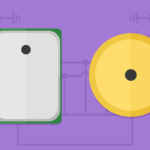What is billed as the world’s first monolithic true MEMS speaker is just one millimeter thick and is said to deliver high fidelity, full-bandwidth sound and low total harmonic distortion (THD) for sealed in-ear personal audio devices, including true wireless stereo (TWS) earbuds. Called Montara by its creator xMEMS Labs in Los Altos, Calif., the MEMS-based device is also the world’s first IP-57 rated microspeaker, enabling water and dust-resistant earbuds.
xMEMS Labs says Montara eclipses early hybrid-MEMS speakers by implementing the entire speaker (actuator and diaphragm/membrane) in silicon, reducing package height and eliminating driver matching and calibration due to inherent variability in membrane assembly. The resulting speaker delivers a 20 Hz-20 kHz output with flat frequency response at >110 dB SPL. The MEMS approach also eliminates the need for driver matching and calibration, and the consistent silicon membrane movement enables active compensation for a THD of below 0.5% (200 Hz ~ 20KHz).
Other benefits of the full-MEMS approach is a mechanical latency of less than 0.1 msec that enables active noise cancellation (ANC) across a wider frequency range, a 10,000g mechanical shock resistance, IP57 water immersion and dust resistance without use of a special membrane, and a low power consumption.

The xMEMS patent (US 10,327,060 B2)provides insights into how a MEMS structure can operate as a loudspeaker. The patent says the technique used to generate sound employs a number of pulses at a rate higher than audible frequencies to vibrate a membrane. The pulses then get amplitude-modulated with the audio signal. The ambient environment serves as a low-pass filter to get the audio signal of interest. However, the patent makes no mention of the pulse rate used in the patent.
According to the patent, if the membrane is driven to move upward, the air is pushed from a front sub-chamber to the back environment through an opening, generating a negative air pulse. If the membrane is driven to move downward, air is pulled from the back environment to the front sub-chamber through the vale and pushed from the back sub-chamber to the front environment through the valve to generate a positive air pulse. Thus air flow within the front sub-chamber is between one set of valves, air flow direction within the back sub-chamber is between the other two valves.
The whole chip is typically comprised of single-crystal silicon but the patent states other materials might be used for different layers.
Montara samples and evaluation kits are said to be available in July to select customers, with mass production orders expected in the first quarter of 2021. Montara will have two LGA package options: Standard (6.05×8.4×0.985 mm) and Side-Firing (Phi 6.1 mm; 6.05×1.0x8.4 mm).




